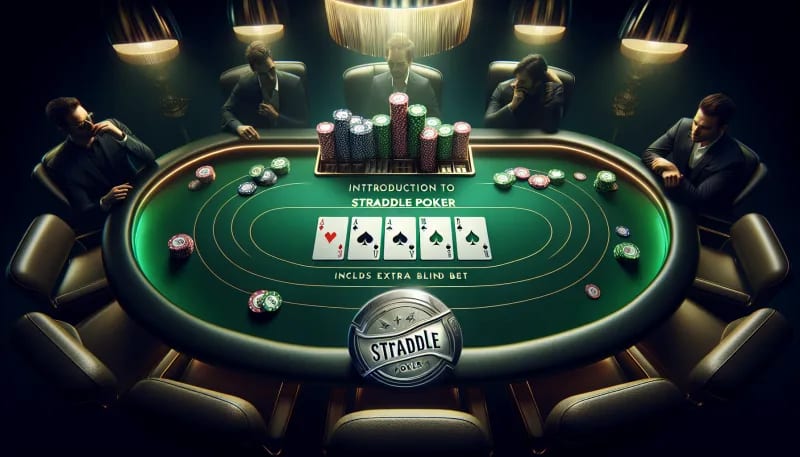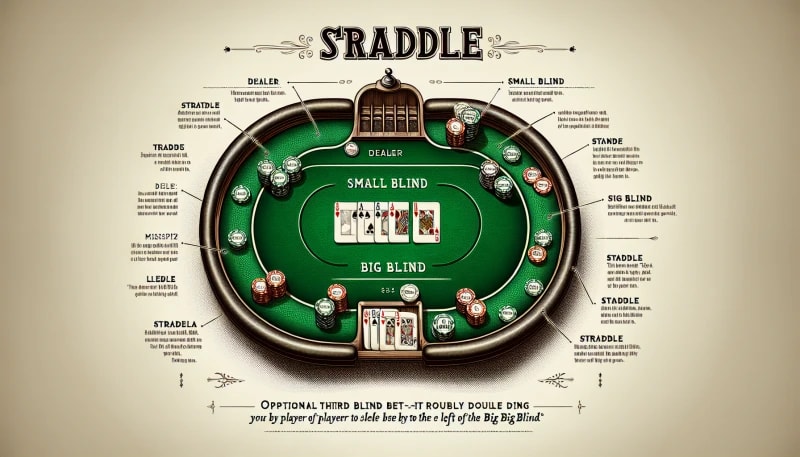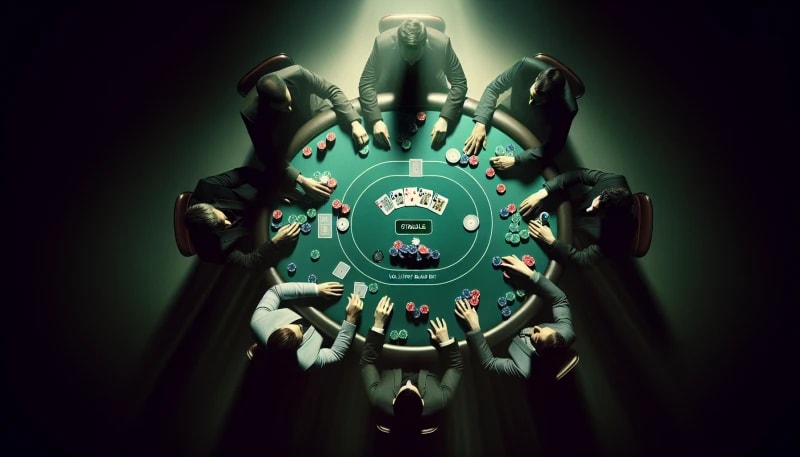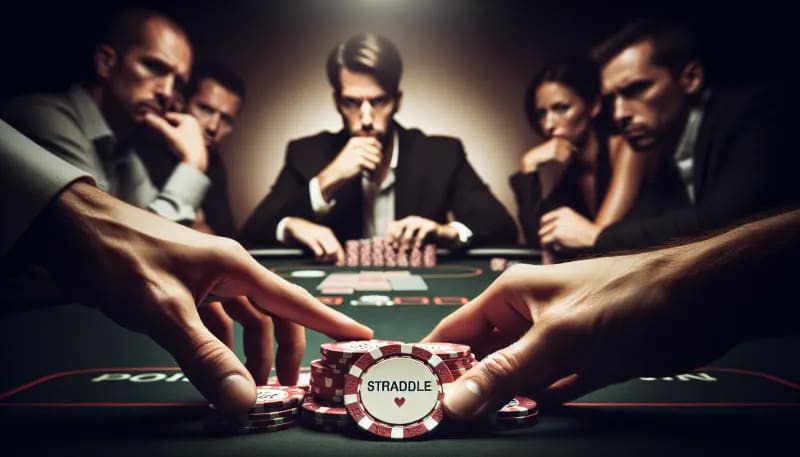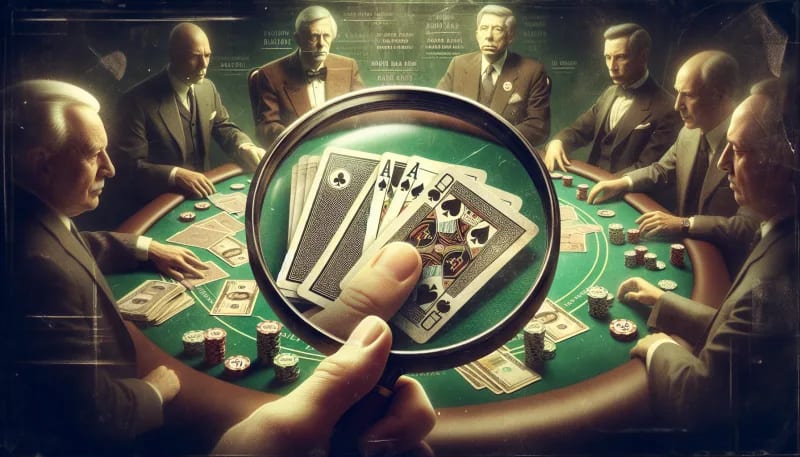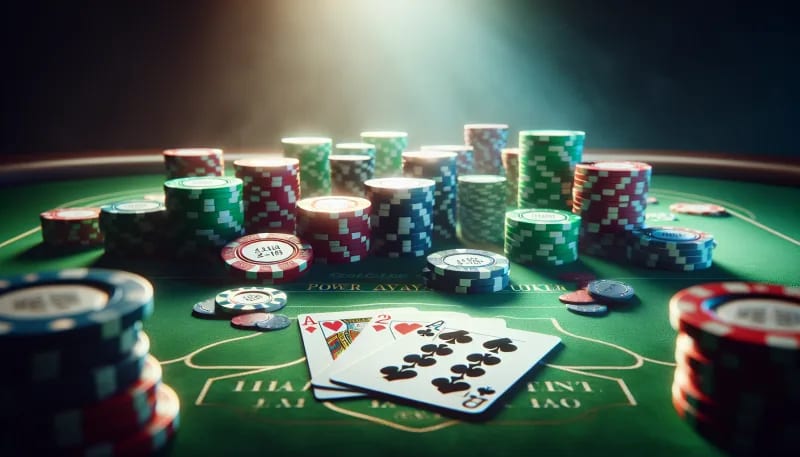The Dynamic Edge of Straddle Poker in Modern Play
Introduction to Straddle Poker
Imagine sitting at a poker table where the action is twice as lively and the stakes soar before the first card hits the felt. Intrigued? I'm talking about Straddle Poker, a thrilling variant that amplifies the traditional game's excitement to a whole new level.
Why does it draw players like moths to a flame? Simple. Straddle Poker infuses the game with a cocktail of heightened anticipation and the potential for bigger pots. It's the adrenaline rush that seasoned players crave and newcomers find irresistible.
In Straddle Poker, you're not just passively waiting for your turn. You're actively shaping the landscape of the game from the get-go. And it's not just about the chips at stake—it's about the strategy, the mind games, and the sheer boldness that comes into play.
Have you ever watched a table and thought, “This could use some more action?” Well, Straddle Poker is the answer. Traditionally passive tables transform into battlegrounds of wit and nerve, making each hand a memorable encounter.
Remember, we're not merely flipping cards here. We're flipping convention on its head. Each hand is a story, and with straddling, those stories become legends. The kind you talk about long after you've folded your cards and stepped away from the table.
As we dive deeper in the following section, "Rules and Mechanics of Straddling," you'll discover how simple it is to up the ante—literally. With just a few adjustments to the rules, Straddle Poker can bring your game night to life. Are you ready to straddle up and push the limits of traditional poker? Let's shuffle up and deal with the intricacies that make straddle not just a move, but a phenomenon.
Rules and Mechanics of Straddling
So, we've dipped our toes into what straddling in poker means in the introduction, but how exactly does it work? When you're at the table, typically, the player immediately to the left of the big blind has the option to straddle. This means they're putting in twice the big blind before the cards are dealt. It's like a third blind, and yes, it spices up the game considerably.
Who's eligible? Any player can straddle if the poker room rules allow it, and they're in the right position. It's usually the player to the left of the big blind, also known as the under-the-gun position (UTG). But can straddling turn the blind structure upside down? You bet it can. By throwing in that extra bet, the straddler gets the last action in the pre-flop betting round. It shifts the dynamics and can pressure opponents to adjust their strategies. Got that mental note down?
Let's talk types. There are a few different flavors of straddles to savor. The most common is the live straddle. The player straddles for 2x the big blind and retains their right to act last before the flop.
Ever heard of a Mississippi straddle? It's a twist where you can straddle from any position. Yes, even the button, which can throw other players for a loop. And the blinds? They act in their usual order despite the new challenger entering the ring with a straddle from afar.
Then there’s the sleeper straddle. Think of it like a straddle lying in wait. The player places a straddle bet, usually from a late position, with the caveat that it only becomes "live" if the action comes around without a raise beforehand. It can feel like a poker ninja move, sneaking up on the unassuming table.
Now that we understand the rules and mechanics, ready to move on to the juicy part? How does this affect your strategy? heightFor more, as we delve into the Strategic Implications of Straddling in the next section.
Strategic Implications of Straddling
Following the breakdown of the rules and mechanics of straddling, it’s key to pivot to the strategic gravity it introduces at the felt. Can a well-timed straddle shift the game in your favor, or might it just inflate the pot for someone else’s taking? Let’s dissect.
Straddling increases the stakes and often forces more conservative players to adjust their game. It places mental pressure, compelling others to play hands they might otherwise fold. By doubling the big blind, it changes the table's betting structure, doesn't it? Your typical opening raise isn’t so standard anymore.
When I straddle, I see it as a power move. It sends a message, claiming territory. It says, “I’m here to gamble.” This move can deter weaker players from entering pots, handing you the upper hand before the cards even hit the table. But remember, it’s a double-edged sword. The gamble is real.
Effective straddle use can create a looser game environment. It encourages action, leading to larger pots and more opportunities for large wins. It adds an element of unpredictability — and isn't that, after all, part of poker’s allure?
Yet, there's a thin line between aggressive play and recklessness. Straddle with caution. An unwarranted straddle can bleed your stack dry, especially if done from early positions. Position is pivotal; a straddle from the button is a strategic masterpiece, while under-the-gun can be a strategic blunder.
But can you use it to your advantage without becoming predictable? Absolutely. Mix up your game. Straddle occasionally but not consistently. Keep your opponents guessing.
Before wrapping up and passing the torch to the psychological warfare that is straddle poker, remember this: straddling should fit into a wider strategy. It’s not just about bulking up the pot; it’s about leveraging your table image and manipulating the flow of the game. Use it wisely, and straddling could very well be the ace up your sleeve.
Psychological Aspects of Straddle Poker
Building on the strategic foundations we've laid, let's delve into the mind games at play. When someone at the table decides to straddle, it's more than just a larger blind. It's a psychological lever, pulled to upset the table's rhythm.
Imagine the scene. The action kicks off not with the big blind but with a straddle. Suddenly, you're not just defending your blinds – you're combating an inflated pot. Does it make you anxious? Aggressive? It's meant to.
A straddle inherently intensifies the atmosphere. It's a statement, a gauntlet thrown that says, "I'm ready to escalate this game." Your heart races; your palms sweat. This isn't your run-of-the-mill hand anymore. Can you feel the tension rising? Because that's exactly what the straddler wants.
Players' mindsets shift when facing a straddle. Some tighten up, folding hands they might have played in a normal round. Others perceive it as weakness—a bluff of sorts—and respond more aggressively. Each decision is now heavier, laden with the extra chips already in the pot.
Then there's the impact on table image. The player who straddles is often seen as a loose cannon, willing to take risks for the thrill. But is it bravado or a calculated move? That uncertainty can make opponents second-guess. Can you exploit that perceived recklessness? Maybe. But only if you don't let it get under your skin first.
Here's the kicker: A straddle doesn't just alter the game's dynamics—it scrambles them. It forces players to adapt, to reconsider their strategies in real-time. Are you ready for the mind games that come with straddled pots?
As we transition from the strategic implications of the move, we set the stage for our next segment: 'Straddle Poker in Cash Games vs. Tournaments'. Here, we'll explore how this bold play translates across different formats. One thing's for sure – the psychological pressure it adds is universal.

Straddle Poker in Cash Games vs. Tournaments
Now, you've just grasped the psychological warfare of straddle poker. But how does this aggressive move play out in cash games compared to the tournament scene? Let's dig in.
In cash games, the straddle is a common beast. It's an optional third blind that adds spice to the mix, typically doubling the stakes and injecting action. The player to the left of the big blind acts first pre-flop, thanks to this blind bet. This revolutionizes the dynamics, don't you agree? More money on the table means larger pots and more aggression. It's the ideal playground for players with deeper pockets and a hearty appetite for risk.
By contrast, have you ever seen a straddle in tournament play? It's like spotting a unicorn! Tournaments rarely feature straddles due to structured blinds and the elusive importance of chip conservation. In the rare instances where it's allowed, straddle bets are often seen as strategic kamikaze missions. The impact? They can create a momentary advantage but also a higher risk of chip depletion. A double-edged sword, to say the least.
For a tournament player, strategically, a straddle might be a desperate measure. Meanwhile, in the cash game realm, it's a calculated intimidation tactic. It boils down to the nature of the games – one with an endgame in sight, the other an endless battle of wits and bankrolls.
What's clear is that straddling is not a one-size-fits-all move. In cash games, it's the thrill-seeker's delight. In the tournament world, it's a wildcard, rarely played and often criticized. But when it works? It's a thing of beauty, causing shifts in the table dynamics that can be legendary.
And speaking of legendary, stay tuned for some tales that will set your poker heart racing in the next part: Famous Straddle Hands and Sessions.
Famous Straddle Hands and Sessions
Straddle poker definitely adds a layer of excitement to the game, doesn't it? It gets even more thrilling when you witness straddle hands creating chaos at high-stakes tables. One legendary hand that springs to mind is from the beloved High Stakes Poker series. Remember when the great Phil Ivey straddled for $1,600 and ended up in a pot over $500,000? Yep, that's the thrilling unpredictability of straddle poker.
Now, let's talk about a hand that still has people talking. It was on Live at the Bike, where a $100 straddle spiraled into one of those pots that make your heart skip. With aggression amped up, the pot grew to six figures. Think about it: One straddle, and BAM, you're in for a house.
But you haven't seen everything until you experience the straddle-heavy games in Macau's Big Game. We're talking about players like Tom Dwan and Andrew Robl facing blinds of $1,200/$2,400 with straddles that could make your head spin. The session that sticks out? When a straddle hand led to a staggering seven-figure pot. Seven figures! It's not poker for the faint-hearted, is it?
Can you imagine the psychological impact on players when the straddle is on? It transforms the pace and unpredictability of the game. Some of the most exciting sessions have spiraled out of a simple straddle. The entire dynamic shifts, making even seasoned pros sweat a little more.
Remember, straddles might spice up cash games, but they're almost non-existent in tournaments. Why? Because it's all about that unique risk-reward dynamic of live cash games. So, as we make our way to the next section, ask yourself this: Are you ready to incorporate straddles into your game? Are you ready for the rush? If yes, stay tuned for some valuable tips on bringing that exhilarating straddle element to your poker sessions.
Tips for Incorporating Straddles in Your Game
Just like those famous straddle hands we talked about, incorporating straddles in your own game can be quite the thrill. But the big question is: When and how should you straddle effectively? Here's my take on making those live-wire decisions.
First things first, consider your bankroll. Straddling can bleed a thin bankroll dry, so ensure you’re playing stakes where a straddle won’t put you at immediate risk of going bust. Bankroll management is key. Can you comfortably afford to place that extra bet?
Next, game dynamics play a huge part. Is it a loose table where everyone’s straddling? Jumping on the bandwagon might maintain the camaraderie and keep the action going. A tight table, though? Maybe save your straddles for another day when you're not surrounded by sharks just waiting to capitalize on your bravado.
Remember, straddling is essentially a blind raise. Essentially, you're putting money into the pot without looking at your cards. Are you comfortable with that level of uncertainty? Can you handle the pressure when the action gets back to you?
Timing is another factor. Strategically, you might straddle to shake up a stagnant session or give the impression of being loose when you’re actually playing tight. In essence, you're setting a trap for your opponents to walk into.
Let’s not forget position. A straddle from the button can be powerful, putting you in a great spot post-flop. Use this to your advantage when the time is right.
In conclusion, straddling isn’t for everyone. It requires a balanced combination of a healthy bankroll, solid game understanding, and the right table dynamics. Ask yourself, is the potential reward worth the risk? If yes, strap in and enjoy the ride—responsibly.
Transitioning to the Future of Straddle Poker, one thing is certain: the landscape of this aggressive move is ever-evolving. As poker continues to grow, who knows how straddling will reshape strategies? Stay tuned.
Future of Straddle Poker
Following up on incorporating straddles into your game, let's look ahead. What does the future hold for Straddle Poker? It's exciting to speculate about the paths it might take.
Straddle Poker continues to introduce an extra layer of strategy and unpredictability. I've noticed more players adopting this tactic, especially in high-stakes games. It's clear the popularity is on the rise. But why stop here? We may soon see straddling becoming a standard feature in tournaments, potentially altering the very fabric of competitive poker.
Can you imagine? All major tournaments adopting a straddle option. That would freshen up the game, wouldn't it? Suddenly, your arsenal of moves grows, and so does everyone else's. This could lead to an evolution of poker strategy at the professional level, trickling down to casual players.
Technology also plays a role. Online poker platforms are starting to experiment with Straddle games. As innovation pushes forward, expect to see new and creative ways to implement straddles in online play. This could mean special bonuses for players who straddle, or specific Straddle-only tables to cater to thrill-seekers.
What’s more, the prevalence of poker streams and TV games showcases the enthrallment of straddle hands. Wouldn’t you agree that the drama of a straddle pot is infectious? It adds a dose of adrenaline that hooks viewers and players alike. This exposure continually fuels the game's growth.
Then there's the social aspect. Straddle hands often lead to larger pots. What does that mean for the table dynamics? Perhaps a bonded camaraderie or an intensified rivalry. Either way, it’s a catalyst for memorable gameplay.
In essence, Straddle Poker’s future seems vibrant. From reshaping tournament structures to enhancing online poker experiences, the straddle influence is expanding. Expect the unexpected, because if poker has taught us anything, it's that the game is always changing. And Straddle Poker is at the forefront of that change.

